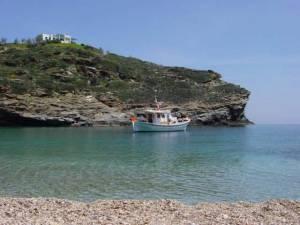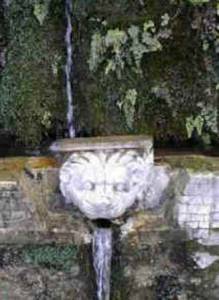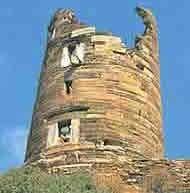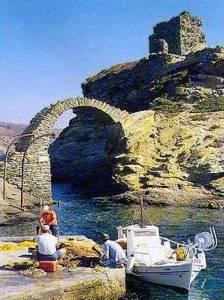Andros, a Walker's Paradise
However you choose to discover the island, you will find that Andros encompasses an amazing natural beauty of mountains, valleys, flora and springs, great beaches with crystal clear water, and beautiful sights illustrating the depth of its culture and the pride of its people.
Andros is a walker’s paradise, and that is certainly one of its major attractions. Regardless of where you base yourself on the island, you will never be far from excellent walks throughout its beautiful countryside. The island also has excellent roads and getting about by motorbike is a great way to tour the island. Whether walking or riding, you will never be far from an excellent beach, whether on its exposed east coast, or on its more sheltered west coast. The island has long been the home of many wealthy ship owners and sea captains, and plenty of elegant estates and horse farms dot the verdant interior of the island. 
Starting on the west coast and moving south from the port of Gavrion, there are two lovely sandy beaches on the way to the first village and seaside resort of Batsi. The village features a very nice town beach, some excellent tavernas, and a few bars that constitute the nightlife of the area. It is an ideal location for families, as the sandy beach is sheltered and very convenient to eating facilities. It’s a very pretty village, with Cycladic architecture and a good tourist infrastructure, as well as having some excellent choices of accommodation, both overlooking the seaside of the village, as well as further south toward the beach of Stivari and onward to Ag. Marina, a lovely picturesque cove. About five kilometers further south, you’ll arrive at the village of Paleopolis overlooking the ancient capital of the island. 
From the present day village, there are 1,039 steps leading down to the old capital and the beach. Inhabited until about 500 AD, you can see the remains of buildings and temples, and parts of the walls and acropolis that are still preserved. Much of the ruins lie beneath the sea as the town was destroyed, either by earthquake or landslide, during the 4th Century. Early explorations of the site in 1833 revealed two important statues, Hermes of Andros and the Great Herculanensis, which are now to be found in the Archaeological Museum in Andros Town.
From here, you can continue southward to Stavropeda where you can join the road cutting cross the island and connecting to Andros Town, the modern day capital and very attractive coastal town of neoclassic and Cycladic mansions and houses, steep and narrow arched alleyways, beautiful churches, a pretty town square at its center, and some very interesting sights to see and explore. Settled by the Venetians in the 13th Century, among the most important monuments of Chora are the remains of the castle, constructed between 1207 and 1233, now in ruins and lying at the tip of the peninsula, just opposite Riva Square with its Statue of the Unknown Sailor. The excellent Archaeological Museum is right in the central square of Kairis. It includes finds from the Geometric, Classical, Hellenistic, Roman, and Byzantine periods. On a side street leading from the square, you will find the Houlandris Museum of Modern Art, with a permanent collection of works by the sculptor Michalis Tombros, and painters Picasso, Matisse, Kandinsky, and Chagall. Every summer, the museum features roving exhibits by world-renowned artists, the most recent having been Klee and C?zanne. Nearby is another museum of mostly modern art, the Kydoneas Foundation. There is also a small Nautical Museum with a rich collection of ship models, photographs, and ship's instruments, though its opening times seem to be a bit uncertain.  Just north of Andros Town is the wealthy and very attractive village of Stenies, home to so many of the island’s seamen. Just a few kilometers west is the village of Apoikia, home to the famous Sariza Springs. From the central square of the village, you can take the steps up to the plant and sample some of their water. Moving south from Andros Town, you will pass over mountainous regions followed by the beautiful and fertile Korthion valley. Between Andros Town and the village of Korthion is the old Venetian castle, Palaeocastro, sitting 583 meters above sea level.
The next village of significance is Korthion, a simple and pleasant village with cafes, tavernas, and two beaches, one at either end of the town. In this region, you can see some of the many simple dovecotes of Andros, legacies of the Venetian settlers. 
There are many lovely walks possible on the island. Here are a few short ones, not too strenuous, and ideal even for “non-walkers.” From the port of Gavrion, you can work your way up to Ag. Petros, about 3 kilometers northeast of the port and high up in the hills. It is the best-preserved ancient monument on the island, and is a 20-meter tall tower dating from the Hellenistic period (photo to the left). From Batsi, you can walk the few kilometers to visit the convent of Zoodochou Pigi. It has a lovely small church inside the grounds, with icons, wall paintings, and tapestries from the Byzantine era. From Andros Town, you can walk the 5 kilometers west to Lamyra, one of the loveliest villages on the island. Above this village, paths connect to three other very pretty villages, Ipsilou, Messathouri and Strapouries. From the lowest to the highest village, the walk entails only 30 minutes.
However you choose to discover the island, you will find that Andros encompasses an amazing natural beauty of mountains, valleys, flora and springs, great beaches with crystal clear water, and beautiful sights illustrating the depth of its culture and the pride of its people. |
|



